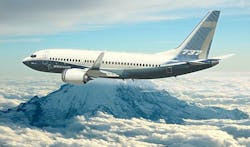Boeing adds fly-by-wire spoilers, electronic bleed-air system to next-generation 737 MAX jetliner to improve fuel burn
RENTON, Wash., 15 April 2012. Passenger aircraft designers at the Boeing Co. (NYSE: BA) Commercial Airplanes segment in Renton, Wash., are making several design changes to their next-generation 737 MAX single-aisle commercial jetliner with an eye towards improving fuel efficiency and emissions. Boeing is launching the new-engine, fuel-efficient 737 MAX in response to the A320neo narrow-body jetliner by archrival Airbus in Toulouse, France.
Boeing engineers will replace a mechanical system with fly-by-wire spoilers in the 737 MAX flight control system to save weight, as well as including an electronic bleed-air system for cabin pressurization and aircraft ice protection, which will improve fuel burn, company officials say. The Boeing 737 MAX is to enter service in 2017.
Boeing engineers also will extend the tail cone of the 737 MAX and thicken its elevator to improve steadiness of air flow and eliminate the need for vortex generators on the tail reduce drag.
Engineers also will integrate the 737 MAX's CFM International LEAP-1B engines with the wing similar to the aerodynamic lines of the 787 Dreamliner engine with its wing.
To do this, designers will use a new pylon, strut and 8-inch nose gear extension to maintain similar ground clearance to today's 737 while accommodating the larger engine. Boeing also will strengthen the 737 MAX's main landing gear, wing, and fuselage to accommodate the increased loads of the larger engines.
A possible revision to the wing tips on the MAX also is being tested in the wind tunnel to see if this new technology could further benefit the airplane.
Airlines operating the 737 MAX will see a 10-to-12-percent fuel-burn improvement over today's most fuel efficient single-aisle airplanes and a 7 percent operating cost per-seat advantage over tomorrow's competition, Boeing officials say.
Like its widebody big brother, the Boeing 787 Dreamliner, the Boeing 737 Max has serrated edges called chevrons for the back of the engine nacelle and the engine exhaust nozzle to reduce jet blast noise by controlling the way the air mixes after passing through and around the engine.
The Boeing 737 MAX family will consist of three models -- the MAX 7, MAX 8, and MAX 9 -- that will have different lengths and different seating configurations. The new jets will feature the 737 Boeing Sky Interior with spacious cabin headroom, overhead bins that disappear into the ceiling yet carry more bags that previous interior configurations, and light-emitting diode (LED) lighting.
To date, the 737 MAX has more than 1,000 orders and commitments from 16 buyers. For more information contact Boeing commercial Airplanes online at www.boeing.com/commercial.
Follow Military & Aerospace Electronics and Avionics Intelligence news updates on Twitter
About the Author
John Keller
Editor-in-Chief
John Keller is the Editor-in-Chief, Military & Aerospace Electronics Magazine--provides extensive coverage and analysis of enabling electronics and optoelectronic technologies in military, space and commercial aviation applications. John has been a member of the Military & Aerospace Electronics staff since 1989 and chief editor since 1995.
